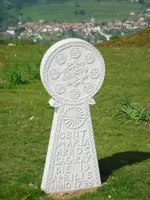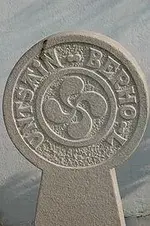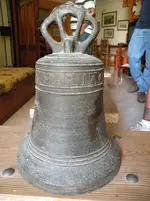Many of my Tnet friends here are fully aware that I was at Berkeley a couple months ago doing my research.
I am writing a book about shipwrecks but it coincides with the history of the early Catholic Church.
I took the time to visit as many historic missions as possible in the hope of expanding my knowledge, and of course, in the effort to give thanks for all the blessings we have received.
I happened to go through some of my files this afternoon and took note of two pictures I would love to share with everyone concerning the bell that is being investigated from the Dominican Rebuplic.
The first picture shows the bells located at the Mission San Gabriel Archangel outside of Los Angeles. This mission was founded on September 8th, 1771, by the Franciscan Friars on Rio Temblores. Due to flooding, the expedition was moved to a second site in 1774, where the mission of stone and red brick was built with the help of Gabrielleno Indians.
This first picture I'm posting is of a massive structure with bells. This is a complete replacement for the bell tower that was destroyed in the 1812 Earthquake of California.
What is unique is the amount of bells, the size of the bells, and notice the different attachments used to hold the bells in place.
There were iron loops and rope used in this effort.
If one looks closer...there is a CROSS OVER A MOUND on the bottom bell...a definate indication of a MISSION.
None of these bells had an "IHS" on them...as they were of the Franciscan Order.
The next picture shows some bells I found at a small museum connected to the Mission of San Rafael outside San Francisco. Founded in 1817, by Padre Vincente Sarria, it was built to assist the nearby Mission Dolores. It originally served as a sanitarium for native converts suffering from San Francisco's generally damper climate. Padre Luis Gil was so successful giving medical care, the asistencia grew to over 1,000 inhabitants!
The bells in the picture are of a much later date than the bell from the Dominican Republic, however, hopefully viewers can become more educated on analyizing church bells. Again...I feel that the "IHS," in most cases, indicates a bell was of the Jesuit Order. The bells from Mission of San Rafael were also for the Franciscan Order and there are no letters of "IHS."
I hope everyone enjoys these bells as much as I did...submerging one's self into history!
Laura










